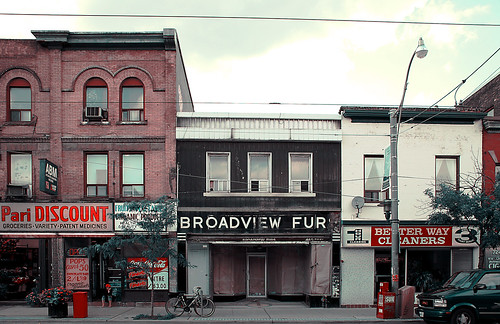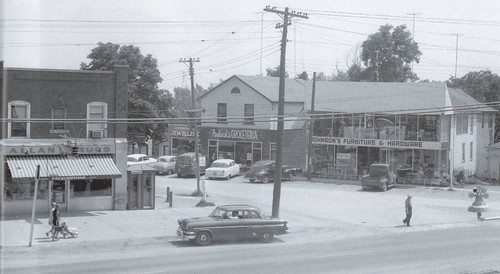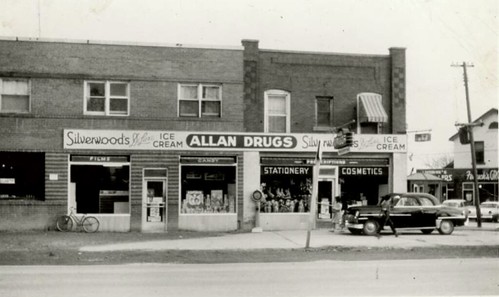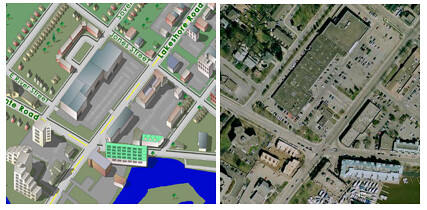
Editor: Spacing is pleased to introduce our newest contributor, Lauren Archer, a budding heritage professional working in and around Southern Ontario. Her posts will explore heritage issues in the GTA, and are crossposted on her own Her*itage and His*tory blog.

For decades the provincial government has been encouraging smaller municipal governments to amalgamate. Counties have become cities, towns and villages have joined to form larger municipal governments and outlying suburbs have been merged into continuous centralized landscapes. These amalgamations, a response to rapidly increasing population sizes, happened two distinct waves in the GTA: the first occurred between the mid-1950s and the late 1970s as a response to the end of World War II. The second, marked by the incorporation of a singular City of Toronto in 1998, is still ongoing. It is generally accepted that these amalgamations allow municipalities to provide services in the most cost-effective and efficient way possible. However, the full extent of the effects of amalgamation are still being explored today.
One such area is Bronte, a small village nestled around the mouth of Twelve Mile Creek in the west end of the Town of Oakville. Bronte was amalgamated with the rest of the Township of Oakville in 1962. As is the case in many of the smaller, subsidiary communities that were amalgamated at this time, the delocalization of government has led to the loss of a significant amount of built heritage.
Because of its proximity to central Oakville, development in Bronte boomed after amalgamation and because of this development the community is currently flourishing. Good development is a good thing, but the Village of Bronte is now just beginning to realize the cultural value that their heritage streetscapes could have had.

Photo from Our Oakville
This streetscape above, for example, was formally found at the corner of Lakeshore Rd. and Bronte Rd. In the background you can see a number of small businesses, such has Fredrick’s Groceteria, Johnson’s Furniture & Hardware, and a Jewellery Store.

Photo from the Bronte Historical Society
In the foreground you can see Allan Pharmacy, built by the original store owners in 1935 and demolished in 1979 when, two generations later, the Allan family decided to move the pharmacy to a larger location with more available parking.

Model image from the Bronte BIA
And here is a 3D model and a satellite image of what it looks like today. The streetscape has been entirely replaced by Bronte Village Mall, a strip of doctor’s offices and a gas station.
Looking at these pictures I tried to evoke the sensibility of the day and thought: “You know, it must have looked really neat right after they tore those buildings down”. The entire street was opened up, you could see the sky from the sidewalk, there was a ton of parking, which was always a problem before and, when the strip malls eventually opened, there was even more space in brand new, modernized buildings for businesses to rent.
It must have seemed like a really good idea, and in a way, it still kind of does. The demand for such properties was probably very high, too high to ignore. Which is why its important to learn from the past, even when you can’t protect it retroactively. In hindsight Bronte had such a beautiful downtown core, and with current planning trends favouring the traditional style of heritage streetscapes, this attractive commercial district would have been ripe for a highly lucrative revitalization project.
Strip malls had (and have) their purpose and thousands upon thousands of them across the continent define North American streetscapes. Today, they all look kind of drab and pathetic to many of us — even if the people and businesses that rent these spaces are really great — but were streetscapes like Old Bronte just the strip malls of their time? Is Bronte Village Mall the desirable heritage streetscape of tomorrow?
You never know. Well, you never know today.
photo by sssteve.o




5 comments
Great article! I really liked how you kept a balanced and realistic approach to urban development, unlike most articles on the topic which tend to simply villainize cars and their infrastructure.
The sad thing about Bronte is that in Canada we are fortunate enough to have all this land to have our cake and eat it too. There is no reason why downtown Bronte could not exist while strip mall developments took place at the edge of the urban area. My guess is that at the time they believed that high density cores were no longer profitable so rather than let it decay, to simply tear it down. Obviously this is before the renaissance of downtown and urban living.
On the topic of amalgamation, it is definitely a tricky and controversial subject. On the pro side, it allows for a shared vision for urban planning and growth. I feel that Halton, Peel, York, and Durham should amalgamate with Toronto to become The City of Greater Toronto. This would help to slow the ‘905 vs 416’ bickering that exists among urban discussions and allow for a shared view of how the Toronto area should operate.
However, you brought up the fact of lack of local representation. David Miller would be a fantastic mayor with no question if his constituency was just downtown Toronto and environs. However his constituency includes many post-war communities, and is also the center of the largest metropolitan area in the country. Whenever an innocent bystander is shot in Malvern, it is easy to do nothing but preach ‘feelgood gun bans.’ However if he was mayor of just Malvern, we would probably see a much harsher response similar to that of the Boxing Day shooting.
Finally, it is kind of ironic that the 416 preaches to the 905 about urban development, yet almost all of these old villages you speak of within the 416 have been bulldozed to make room for strip malls.
Actually, it would have been interesting to compare Bronte Village Mall to the condos at the SW corner of Lakeshore + Bronte–the latter being 20 odd years newer and a much more determined postmodern gesture toward the “traditional streetscape” idea, with a little urban-intensification thrown in for good measure. Unfortunately, on behalf this kind of stuff, *real* traditional streetscapes (is that where that Patrick’s Groceteria was?) tend to go (and in Bronte, continue to go–head on down to the foot of Bronte Rd for proof). Still, I wouldn’t be surprised (economy notwithstanding) if Oakville commissions a traditional-minded redevelopment of the Bronte Village Mall site someday–especially as the municipality has been one of the more aggressive adaptors of New Urbanist precepts out there.
Though when it comes to Oakville, my sleeper favourite traditional-yet-not-traditional streetscape is Kerr Village (the traditional heart of the “poor side of town”, where the Salvation Army Thrift Store takes precedence over Starbucks), where the predominant tone is that of “banal” 50s/60s/70s stripitecture–yet it follows the streetline! (Lakeshore east of Hurontario in Port Credit is similar in vintage + demeanour, if marginally more genteel-ish by default.) I don’t want to claim that it’s “heritage”, but it’s definitely got its own idiosyncratic authenticity, and I like it a lot better than if it were cutesy-pooed into an overwrought “heritage streetscape” aesthetic (keep that EIFS stucco fakery away!)
Dominion Seed House a Canada Heritage now gone too ?
http://www.topix.net/album/detail/ca/halton-hills-on-georgetown/UDASSCUDP68GHJ69
I just want to say I’m glad somebody captured the fantastic storefront of Broadview Furs before it was renovated. It was so beautiful to see it revealed, and I was so sad to see it gone.
The un-attributed photo at the beginning of the article is actually a small section of Queen St.E, just east of Broadview, in Toronto. The area is referred to as Riverside.
It’s a great neighborhood. I would love to read an article that features that area’s history.